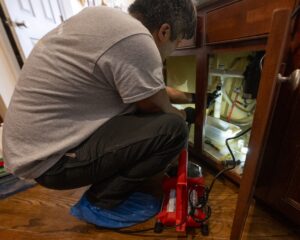When Drano Makes Your Drain Problems Even Worse
Hey there! So you’ve got a clogged drain, reached for that bottle of Drano under the sink, followed all the instructions on the label, maybe even gave it a second dose for good measure… and now your drain is flowing even slower than before. What gives?
Don’t worry, you’re not alone. As plumbers here in Richmond, we hear this exact story nearly every week. People are looking for that quick DIY fix (and honestly, who can blame them?), but chemical drain cleaners often end up making the situation worse instead of better. Let’s chat about why that happens and what you can do about it now.
What’s Actually Happening When Drano Backfires
The Partial Clear Problem
Here’s something most people don’t realize: Drano and similar products typically only create a small channel through the clog rather than removing it completely. Think of it like poking a tiny hole through a cork – some water can get through, so you might think the problem is solved, but that narrow passage gets blocked again really quickly.
What’s left of your original clog is still clinging to the sides of your pipes, ready to catch more hair, grease, soap scum, and anything else that goes down your drain. Within a few days, you’re right back where you started – except now the clog is even more stubborn than before.
The Chemical Thickening Effect
Ever noticed how some substances actually get thicker when you add certain chemicals? That’s exactly what can happen in your pipes. If your clog consists of materials that don’t dissolve well in chemical cleaners (like hair mixed with soap scum, certain oils, or toothpaste buildup), the Drano might actually cause that gunk to swell up and harden.
I’ve personally pulled out clogs that were transformed from soft, removable masses into rock-hard lumps after chemical treatment. Once that happens, no amount of plunging will help – you need professional tools to break through.
Pipe Damage You Can’t See
One of the most concerning issues happens behind the scenes where you can’t see it. Chemical drain cleaners work by creating a heat-generating reaction that’s supposed to melt through the clog. That heat doesn’t just affect the blockage – it also affects your pipes.
In PVC plumbing, this heat can cause warping or weakening at joints and connections. In older metal pipes, it accelerates corrosion from the inside out. The damage might not cause an immediate leak, but it’s putting your plumbing system on borrowed time. Many homeowners don’t make the connection when a pipe fails months later that it was actually their repeated use of chemical cleaners that set the stage for the problem.
The Lingering Chemical Issue
Think all that Drano just washes away after it’s done its job? Think again. In plumbing systems with P-traps, U-bends, and other curved sections (which is most systems), some of that caustic chemical mixture can settle and remain in those low points.
This is especially true when water flow is already reduced because of a partial clog. Those chemicals continue to work long after you’ve walked away, slowly eating away at your pipes from the inside. It’s like leaving a pot of acid on a slow simmer – nothing good comes from that.
When It’s Time to Call in the Pros
Let’s be real about when DIY methods have run their course. Here are the signs it’s time to pick up the phone instead of another bottle of drain cleaner:
- Your drain is flowing more slowly after using Drano
- Water is backing up into other fixtures in your home
- There’s a chemical smell or burning odor coming from the drain
- You notice bubbling or gurgling sounds in nearby drains
- You’ve already tried multiple chemical treatments without success
- The area around your pipes feels unusually warm
- The same clog keeps returning within days of treatment
Don’t wait until you’re dealing with a full-blown plumbing emergency. Chemical damage to pipes is cumulative – each exposure weakens the system a little more. And unlike your skin, pipes don’t heal themselves. Once they’re damaged, they’re damaged until they’re repaired or replaced.
Our Approach to Fixing Chemical Cleaner Disasters
When you call us about a drain that’s worse after using chemicals, we take a methodical approach to solve the problem safely and completely:
1. Getting Your Full Story
Before we do anything else, we’ll ask about what you’ve already tried. What products did you use? How much? When? Has the drain’s behavior changed since then? This information isn’t just making conversation – it helps us understand what we’re dealing with and what precautions we need to take.
2. Safety Assessment
If there’s a possibility of chemical residue still in the pipes, we’ll proceed carefully. Chemical burns are no joke, and protecting both our team and your household is priority number one.
3. Proper Tools for the Job
Instead of adding more chemicals to the situation, we use mechanical methods to physically remove the blockage. Professional-grade augers, specialized drain snakes, and hydro-jetting equipment can clear clogs that chemicals can’t touch – without adding heat or caustic substances to your plumbing.
4. Visual Inspection
For stubborn or recurring clogs, we might use a specialized camera to actually see what’s happening inside your pipes. This helps us identify not just the immediate blockage, but also any damage or underlying issues that might have contributed to the problem.
5. Complete Cleaning
We don’t just poke a hole through the middle of the clog – we remove it completely and clean the interior pipe walls. This prevents rapid re-clogging and gives you a truly free-flowing drain.
6. Education for Prevention
Before we wrap up, we’ll explain exactly what happened, show you what we found (if possible), and provide guidance on preventing future clogs without resorting to harmful chemicals.
Common Questions About Post-Drano Problems
Why did my drain get slower after using a chemical cleaner?
Most likely, it partially broke down the clog but then the debris resettled, creating an even tighter blockage than before. Think of it like stirring up sediment that then forms a more compact layer.
How long do I need to wait after using Drano before calling a plumber?
Most chemical residue will be diluted within 24-48 hours if water is flowing. But if your drain is severely clogged, those chemicals might still be present. Always let us know what you’ve used so we can take appropriate precautions.
What’s a safer alternative to try before calling a professional?
A good plunger (used properly) and a simple drain snake are your best DIY options. Also effective is a mixture of baking soda followed by vinegar, though this works better for maintenance than for severe clogs.
Let’s Fix It Right The First Time
When your drain backs up, I understand the temptation to reach for what seems like a quick, easy solution. But as we’ve seen, chemical drain cleaners often create more problems than they solve.
Instead of making a bad situation worse, give us a call at the first sign of drainage issues. We’ll bring the right tools, proper training, and honest solutions to get your plumbing flowing freely again – without compromising your pipes or your safety.
Your future self (and your plumbing system) will thank you for handling the problem the right way from the start.
